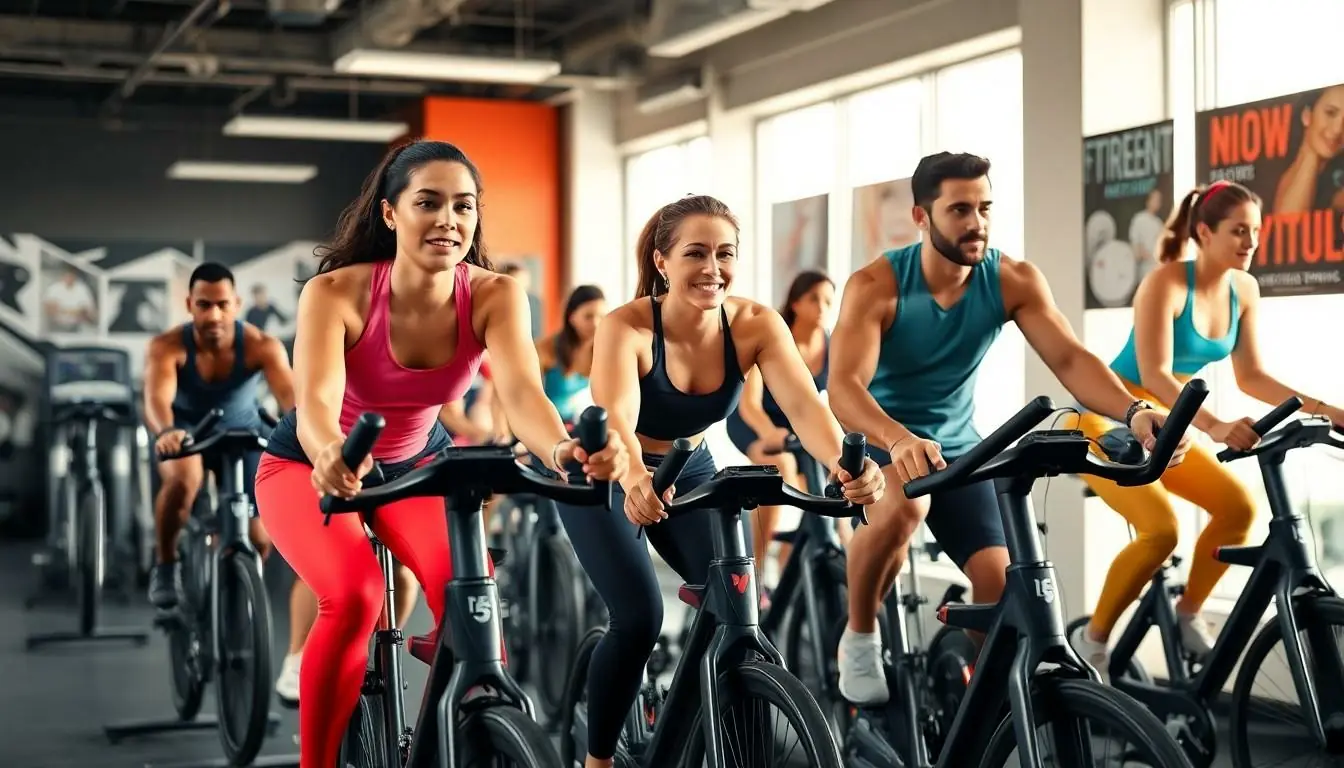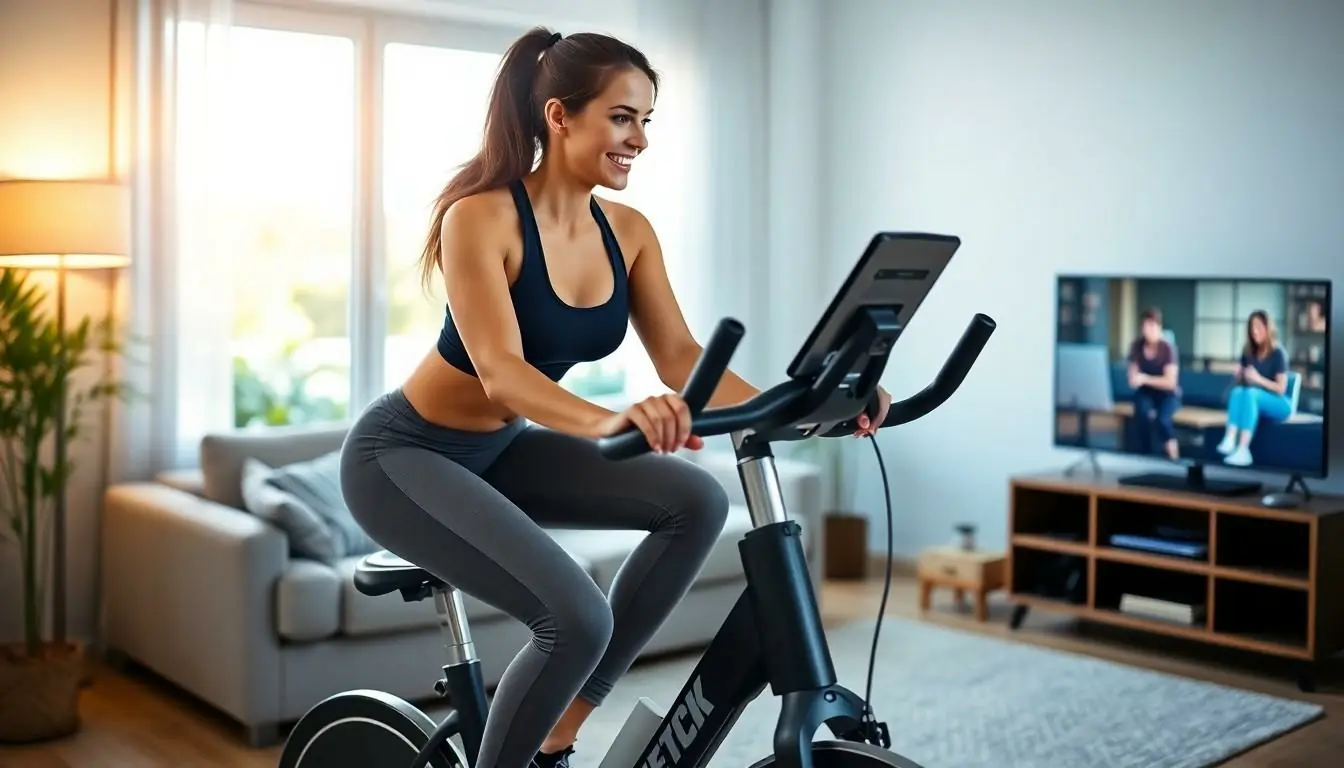Looking to shed those stubborn pounds without stepping foot outside? An exercise bike might just be the secret weapon he didn’t know he needed. Picture this: pedaling away in the comfort of home while binge-watching the latest series. Who said losing weight had to be a chore?
Table of Contents
ToggleBenefits Of Using An Exercise Bike For Weight Loss
Using an exercise bike for weight loss offers multiple benefits. This equipment can enhance fitness levels while providing comfort and convenience.
Cardiovascular Health
Engaging in regular sessions on an exercise bike strengthens the heart. Improved circulation results from this activity, reducing the risk of cardiovascular diseases. Studies show that aerobic exercises, such as cycling, can lower blood pressure and cholesterol levels. Participants often experience increased endurance and greater lung capacity, making daily activities easier.
Calorie Burning
Cycling efficiently burns calories, contributing directly to weight loss. On average, a 155-pound person can burn around 260 calories in 30 minutes of moderate cycling. Intensity levels can vary to increase calorie expenditure. Higher resistance settings challenge the body, leading to more significant results while participants engage in their preferred entertainment, such as watching TV.
Low Impact on Joints
The exercise bike offers a low-impact workout option. It minimizes strain on the joints while delivering an effective cardio routine. This aspect proves particularly beneficial for individuals recovering from injuries or those with joint issues. Regular use can aid in building strength without exacerbating existing pain, encouraging longer and sustainable workout routines.
Types Of Exercise Bikes

Exercise bikes come in several varieties, each catering to different preferences and fitness goals. Understanding these options aids in selecting the best bike for effective weight loss.
Upright Bikes
Upright bikes provide a traditional cycling experience, simulating outdoor riding. These bikes typically have a vertical seat position, engaging the core and upper body during workouts. Users can adjust the resistance levels easily, allowing for customizable training intensity. Research shows that a 155-pound person can burn around 260 calories in 30 minutes of moderate cycling on an upright bike. A major advantage lies in their compact design, making them suitable for small spaces.
Recumbent Bikes
Recumbent bikes feature a laid-back seating position, promoting reduced strain on the back and joints. Cyclists sit in a comfortable chair-like seat with a larger back support, making workouts more accessible for those with mobility issues. These bikes often come with extensive features like built-in programs and heart rate monitors. A 155-pound individual could burn approximately 200 calories in 30 minutes on a recumbent bike, making this option efficient for weight loss. Its design encourages longer sessions as users experience less fatigue.
Indoor Cycle Bikes
Indoor cycle bikes mimic the design and performance of road racing bikes, targeting high-intensity training. Users sit in a forward-leaning position, promoting an engaging and challenging workout. Many indoor cycles come equipped with flywheels and adjustable resistance to simulate outdoor cycling conditions effectively. A 155-pound person could burn about 300 calories in 30 minutes while using an indoor cycle bike. This style emphasizes speed and endurance, attracting dedicated cyclists and fitness enthusiasts.
Key Features To Consider
When selecting an exercise bike for weight loss, certain features greatly influence the overall experience and effectiveness. Understanding these features helps make an informed decision.
Resistance Levels
Resistance levels significantly impact workout intensity. Multiple options allow users to customize their cycling experience. Many bikes offer adjustable resistance settings, enabling users to challenge themselves as they progress. This feature supports varied training routines and targets different muscle groups, increasing calorie burn and promoting weight loss.
Adjustable Seat and Handlebars
An adjustable seat and handlebars enhance comfort during workouts. Various heights and positions cater to different body types. Proper alignment prevents strain and enhances efficiency, allowing longer rides without discomfort. Users achieve better posture through adjustable settings, which contributes to overall performance and enjoyment.
Built-in Workout Programs
Built-in workout programs provide structured routines tailored for various fitness levels. These programs often focus on weight loss, endurance, or interval training. Engaging with predefined sessions keeps workouts fresh and motivating. Users can monitor progress through metrics, such as calories burned and workout duration, promoting accountability.
How To Incorporate An Exercise Bike Into Your Routine
Incorporating an exercise bike into a routine enhances weight loss efforts effectively. Establishing clear, achievable goals provides motivation and direction. Setting weight loss targets, such as losing 1 to 2 pounds per week, helps to maintain focus. Specific milestones like biking a certain distance or duration create further benchmarks. Choosing both short-term and long-term objectives fosters commitment to the exercise regimen.
Setting Goals
Goals play a vital role in guiding exercise routines. Identify fitness targets aligned with individual preferences to optimize success. Aim for a consistent weekly schedule, such as cycling three to five times a week for 20 to 40 minutes each session. Gradually increasing intensity fosters both endurance and strength. Adjusting goals based on performance encourages continued progress and adapts to changing fitness levels.
Sample Workout Plans
Sample workout plans can help structure effective sessions. For beginners, a simple plan might include alternating between 1 minute of high intensity and 2 minutes of low intensity for a total of 30 minutes. More experienced users could adopt a plan featuring steady-state cycling for 30 minutes followed by interval training, alternating between 3 minutes at a moderate pace and 1 minute at a fast pace. Mixing varied intensities keeps workouts engaging and shows significant calorie-burning potential.
Tracking Progress
Tracking progress ensures accountability and motivation. Utilize fitness apps or journals to log cycling sessions, noting duration, resistance, and perceived exertion levels. Reviewing weekly or monthly trends reveals insights into improvements and areas needing focus. Measuring progress against set goals, such as weight lost or workout completed, boosts motivation. Gathering data fosters a clearer understanding of personal growth in the weight loss journey.
Using an exercise bike for weight loss offers a practical and enjoyable approach to fitness. It allows individuals to engage in effective workouts while enjoying other activities. With various bike types available everyone can find a suitable option that meets their needs and preferences.
The combination of low-impact exercise and customizable resistance levels makes cycling accessible for all fitness levels. By setting realistic goals and maintaining a consistent routine users can maximize results and track their progress effectively. Incorporating an exercise bike into a daily regimen not only supports weight loss but also promotes overall health and well-being. Embracing this versatile tool can lead to lasting lifestyle changes and a healthier future.





